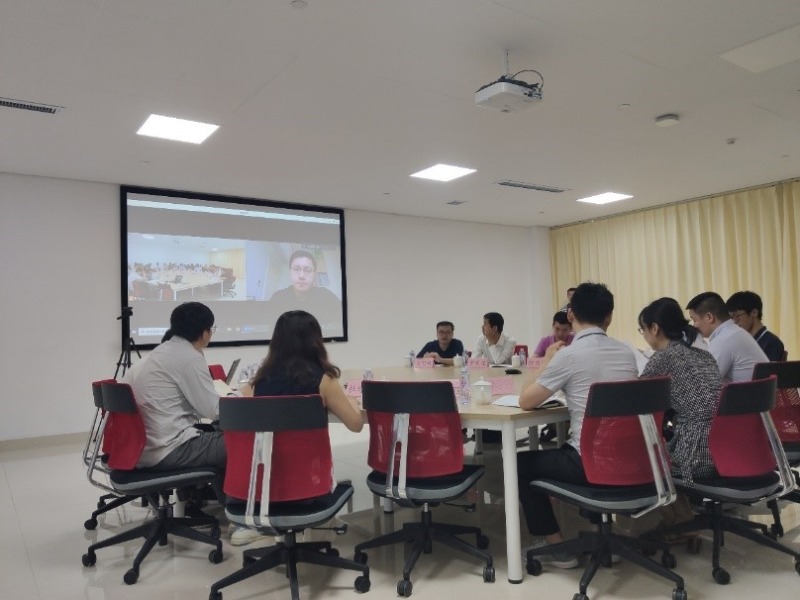Shandong Institute of Advanced Technology Successfully Held the Thermal Radiation Special Workshop
On July 22, 2021, Shandong Institute of Advanced Technology (SDIAT) successfully held the "Thermal Radiation Special Workshop". The conference invited the following experts: Associate Professor Meijie Chen from the School of Energy Science and Engineering, Central South University; Associate Professor Yu Gu from the School of Materials Science and Engineering, Nanjing University of Science and Technology; Associate Professor Yu Qiu from the School of Energy Science and Engineering, Central South University; Distinguished Associate Professor Cunhai Wang from the School of Energy and Environmental Engineering, University of Science and Technology Beijing; Assistant Professor Mingjian He from the School of Energy Science and Engineering, Harbin Institute of Technology; Assistant Researcher Minggang Luo from the School of Energy Science and Engineering, Harbin Institute of Technology; and Postdoctoral Researcher Kezhang Shi from the College of Optical Science and Engineering, Zhejiang University.
Professor Zheng Cui, Director of the Thermal Science Research Center at the Shandong Institute of Advanced Technology (SDIAT), attended and delivered a welcome speech, with Associate Professor Xiaohu Wu chairing the event.
No. 1 Cunhai Wang
Report Title: Multiscale Photothermal Radiation Transfer
Dr. Cunhai Wang provided a detailed explanation of macroscopic medium radiation, microscopic far-field radiation, radiative cooling, and other aspects. Focusing on the theme of "photothermal radiation characteristics," he outlined future research directions from both microscopic and macroscopic perspectives, which hold promise for promoting basic applications, emerging interdisciplinary fields, and frontier scientific development.
No. 2 Meijie Chen
Report Title: Sky Radiative Cooling Technology and Its Applications
Dr. Chen Meijie focused on the theme of radiative cooling, starting with daytime radiative cooling technology. She explained the implementation methods, coating preparation, and other aspects of daytime radiative cooling, and also introduced the application prospects and cases of radiative cooling.
No. 3 Yu Gu
Report Title: Application of Infrared Localized Surface Plasmon Resonance (LSPR) in Radiative Cooling
In her presentation, she provided a detailed introduction to infrared Localized Surface Plasmon Resonance (LSPR) and its applications in radiative cooling. She also discussed exploratory work on LSPR in the infrared band regarding diffusion carriers, ITO particles, and other aspects.
No. 4 Yu Qiu
Report Title: Study on Concentration and Heat Absorption Mechanisms and Performance Optimization of High-Temperature Concentrating Solar Systems
Dr. Yu Qiu provided a detailed introduction to high-temperature photothermal systems, covering research on light energy capture characteristics, analysis of photothermal conversion mechanisms and performance optimization, coupled heat transfer enhancement in light and flow fields, complex-structured molten salt heat exchange equipment, and ultra-high temperature tower-type concentrating solar thermal technology.
No. 5 Mingjian He
Report Title: Study on Near-Field Thermal Radiation Based on Electromagnetic Modulation of Graphene
Dr. Mingjian He focused on the theme of "near-field radiative heat transfer," starting from aspects such as modulation methods of radiative heat transfer, system structures, and forms of graphene materials. He provided a detailed introduction to near-field radiation in multibody planar systems, thermal radiation in planar-particle interactive structures, and near-field radiation regulated by graphene.
No. 6 Minggang Luo
Report Title: Multibody Near-Field Radiative Heat Transfer in Dense Particle Systems
Dr. Minggang Luo focused on near-field radiative heat transfer in dense particle systems, introducing multibody interactions and radiative heat diffusion. He elaborated on multibody radiative heat transfer in metal nanoparticles and lattice-structured nanoparticles, near-field self-radiative heat flux in particle systems, effective thermal conductivity of phase-change particle chains, and macroscopic particle system thermal diffusion theory.
No. 7 Kezhang Shi
Report Title: Near-Field Thermal Radiation Enhancement via Surface Resonance Modes Coupling
Dr. Kezhang Shi focused on introducing the near-field thermal radiation enhancement mechanism based on the mutual coupling of multiple Surface Plasmon Polariton (SPP) modes and Hybrid Polariton (HPP) modes.
This workshop responded to the call and trend of "carbon peaking and carbon neutrality," focusing on key scientific issues in engineering thermophysics fields such as thermal energy conversion and thermal system management. It conducted in-depth discussions on academic frontiers and technological applications in the field of thermal radiation. From theoretical research on near-field radiative heat transfer and multiscale photothermal radiation to practical applications such as solar photothermal systems and radiative cooling, the workshop's content covered the most promising and challenging directions in the current thermal radiation field. It provided insights into clarifying existing challenges and future development directions in thermal radiation research, and is of great significance for promoting efficient energy utilization and spurring the emergence of new technologies, models, and industrial forms.





